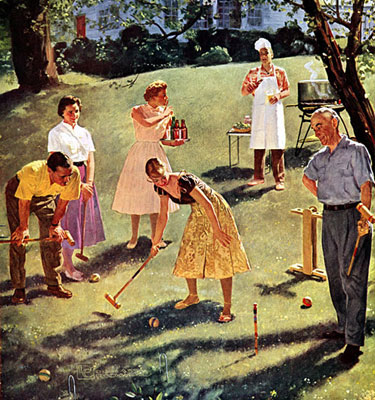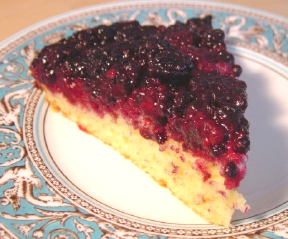 When a wine is described as "jammy" I always think of blackberries. Rich, ripe, fruity flavors so intense they almost taste more cooked than fresh. Blackberries, when fully ripe and sweet, not sour, taste like jam to me. Jammy also means "lucky" according to an Australian English dictionary I recently consulted. I think one slice of this cake will make you feel very lucky indeed! I certainly feel lucky to have gotten the berries from my friend Alton who brought them back from his mountain cabin hideaway, Shadow Woods.
When a wine is described as "jammy" I always think of blackberries. Rich, ripe, fruity flavors so intense they almost taste more cooked than fresh. Blackberries, when fully ripe and sweet, not sour, taste like jam to me. Jammy also means "lucky" according to an Australian English dictionary I recently consulted. I think one slice of this cake will make you feel very lucky indeed! I certainly feel lucky to have gotten the berries from my friend Alton who brought them back from his mountain cabin hideaway, Shadow Woods.
I'm assuming since you are visiting this site, that you probably use the internet to find recipes. I sure do. One thing I particularly find useful are the reader comments. For example the recipes on Epicurious often have suggestions from readers on changes and improvements they have made to the posted recipes. Sometimes their suggestions make sense, though not always.
This recipe started out as one I found online, but based on reader comments, a little experimenting, and ultimately my own experience I made it my own. How different is it from the original?
Retro Recipes and Traditional Fare
Retro Recipes and Traditional Fare
Meat and Potatoes Can Be Good Food
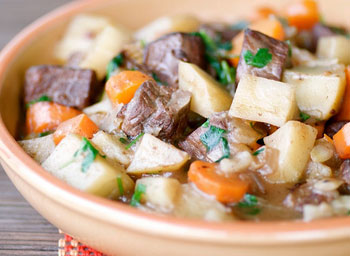 One day when I was a little girl watching my mom make dinner, I asked her why we weren't a "meat and potatoes" family. She said, "That's because we're Italian, and we eat good food."
One day when I was a little girl watching my mom make dinner, I asked her why we weren't a "meat and potatoes" family. She said, "That's because we're Italian, and we eat good food."
I remember thinking, was meat and potatoes bad food? Would it make you sick? I suddenly felt sorry for all those kids at school whose moms cooked meat and potatoes. I secretly wished I could bring them home for dinner so they could have good food like my mom's eggplant parmigiana, escarole and beans, and macaroni with gravy and meatballs.
Other than the once-a-year New England boiled pot roast with potatoes and carrots, my mom never made meat and potatoes meals, and I don't either. The closest I get to making meat and potatoes is a burger and fries, which suits Jeff just fine since his mother also never made meat and potatoes.
Homemade Shepherd's Pie
 I do love this time of year and cooking in a somewhat cooler climate makes me happy.
I do love this time of year and cooking in a somewhat cooler climate makes me happy.
Two years ago I started making Shepherd’s Pie and much to my surprise, everyone at my dinner table fell in love with it. It’s a simple dish, made with everyday, fridge and pantry ingredients. One more feather in this recipes cap – it’s a one pot dish.
Using the white part of the leeks (saving the green part for my homemade stock), and left over mashed potatoes, I am proud to say that I can feed my family of five (with leftovers for lunch the next day) for about ten bucks.
I am working on accomplishing that task most nights. Making wholesome meals, using fresh ingredients for a few dollars makes me happy and giddy. I cannot wait to share more of my “happy meals” with you.
The Best Coconut Macaroons
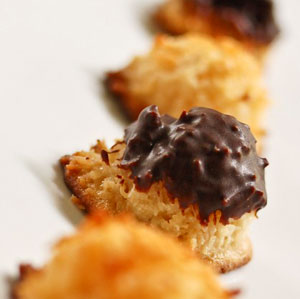 I have always been a fan of macaroons; almond, hazelnut, pistachio, and especially coconut. Through the years, I have made lots of versions of this classic Passover cookie, but none as good as the one’s I found on The Michaels Restaurant Blog.
I have always been a fan of macaroons; almond, hazelnut, pistachio, and especially coconut. Through the years, I have made lots of versions of this classic Passover cookie, but none as good as the one’s I found on The Michaels Restaurant Blog.
Last year, I made over 400 macaroons for the Passover Seder at our Temple. Although I enjoyed making them, I didn’t want to look at another macaroon for some time.
This past week our temple hosted a journey through Egypt, ending with a Seder (for the kids only). Obviously, I was asked to bring the macaroons.
This recipe for macaroons is simply one of the best. And each and every time I bring these to someones house, I am reminded of how good they are by how well they are received.
Woodrow's Favorite - Jesse Wilson's Charlotte Russe
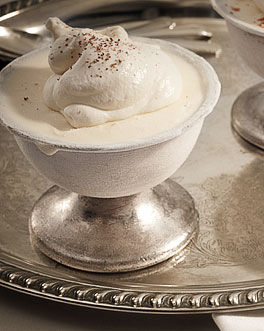 In 1919, after the end of World War I, Woodrow Wilson declared the first Armistice Day.
In 1919, after the end of World War I, Woodrow Wilson declared the first Armistice Day.
His mother, Jesse Woodrow Wilson, 1826-1888, wrote a handwritten recipe book. Among the recipes was one labeled - "Woodrow's favorite - Charlotte Russe" see below...
"Put in a kettle one ounce of gelatin, one quart of water, one-half pint of milk, one pound of sugar, yolks of four eggs and four spoons of sugar. When these ingredients are well mixed pour them upon yolks, and scald them -- stirring all the while; then strain it through a sieve ane pour it while hot on the four whites which must be beaten to a froth. Stir it constantly -- when it is cold, add a syllabub prepared as follows: One-half pint of cream, the remainder of the sugar, churn it, then lay it upon a sieve so that all the milk may drain out. Stir constantly until cold."
More Articles ...
Welcome to the new One for the Table ...
Our Home Page will be different each time you arrive.
We're sure you'll find something to pique your interest...

